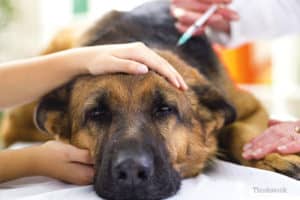 Most dog bites happen to children. There are a variety of reasons for this: Children often don’t know how to interact properly with dogs, and adults often fail to adequately supervise such interactions. In addition, a dog who has limited or negative experience with children may be anxious and defensive around them, which can lead to a bite. All of this adds up to a potentially dangerous situation for both the child and the dog.
Most dog bites happen to children. There are a variety of reasons for this: Children often don’t know how to interact properly with dogs, and adults often fail to adequately supervise such interactions. In addition, a dog who has limited or negative experience with children may be anxious and defensive around them, which can lead to a bite. All of this adds up to a potentially dangerous situation for both the child and the dog.
It is never OK to force a dog to tolerate inappropriate behavior (rough petting, pulling the dog’s ears, grabbing his tail) from a child; at the same time, it’s not OK to compel a nervous child to interact with even the most patient dog. If either the child or the dog shows signs of discomfort or displeasure, the situation needs to immediately be addressed by an adult, using tactics like separation or redirection.
Keeping Kids — And Canines — Out of Harm’s Way
Not every dog can interact happily and safely with children; some dogs do better if they are separated from the crowd when children come over.
If your dog is anxious around children but only has rare encounters with them, such as when out-of-state grandkids come to stay, overnight boarding or doggy day care can be a useful option. A safe room is also a simple way to keep kids and dogs separate during a visit.
In some cases, dogs who are initially nervous around children can be trained to interact safely with them, but this must be done with great caution. A dog who acts unsettled around children needs professional help, starting with a veterinary behaviorist or veterinarian working in conjunction with a certified professional dog trainer. A professional can help you to determine if the situation can be safely resolved and can help you take the necessary steps to address the dog’s behavior. If your dog seems unusually unsettled by children, start by calling your veterinarian and asking for help.
The Rules of Safe Interaction. For kid-friendly dogs, there are ground rules that should be followed during the holidays (or any time) to keep interactions smooth and safe:
Keep greetings calm. Even well-mannered dogs can get excited during greetings, and this can spell disaster for small children who can easily be frightened or knocked down by an enthusiastic canine. Keeping your dog on a front-clip harness and leash during greeting offers greater control over the dog’s forward motion, which limits the probability of small guests getting intimidated or injured. Greeting outside on the front lawn or in another open area, rather than in an enclosed space like a narrow hallway or entry, can also help keep your dog’s enthusiasm under control.
Reward your dog for calm behavior. Treat your dog for holding a sit or down stay during greetings. If the visiting child is comfortable with your dog, you can let her offer the reward. Small children can be taught to toss treats on the floor for your canine, while older children can learn to offer a treat on a flat, outstretched hand.
Carefully introduce the baby gear. Keep in mind that the strange equipment that comes with children, like strollers, car seats, walkers and toys, can be frightening for a dog. Let your dog investigate these things at his own pace and reward him with treats for his bravery.
Supervise all interactions. I can’t say this enough: An adult needs to be present for every encounter between your dog and any visiting children. Contain your dog in a safe area when supervision isn’t possible. If either your dog or the child is uncomfortable in the situation or indicates a need for space, the interaction must stop immediately.
Give the dog some space. Children should be told not to approach your dog while he is sleeping or eating, or when he has a special toy or chewy. As a safeguard, feed your dog his meals or edible chews inside areas secured by barriers.
Teach the right way to touch. Petting should be allowed only when the dog initiates contact and should be done in the direction of the dog’s fur, avoiding sensitive areas. Children should never ride or lie on the dog, and they should not be allowed to kiss the dog or put their face near his.
Keep paws on the floor. Do not encourage or allow children to pick your dog up; there’s a real risk that the child may drop the dog or that your dog may panic when he is restrained. If a child wants to hold your dog, have her sit cross-legged on the ground and let the dog move onto her lap on his own. If your dog wants to move away from the child, he must be allowed to do so and should not be held in place or followed.
With careful supervision, clear rules and appropriate redirection, most dogs are able to settle in and relax even when children are present. In fact, your dog may even come to relish the chance to spend time with children, which makes the holidays that much sweeter for everyone.
This blog was written by McQueen Animal Hospital, an animal clinic (vet hospital/vet clinic) in Brampton committed to providing only the highest level of veterinary care to our beloved pets.




